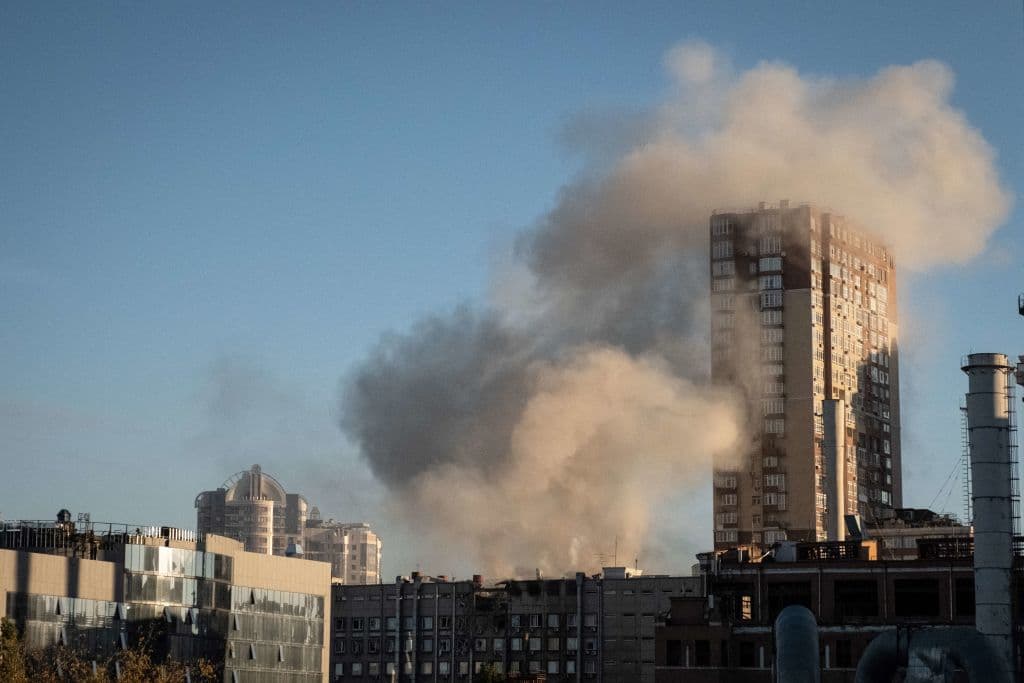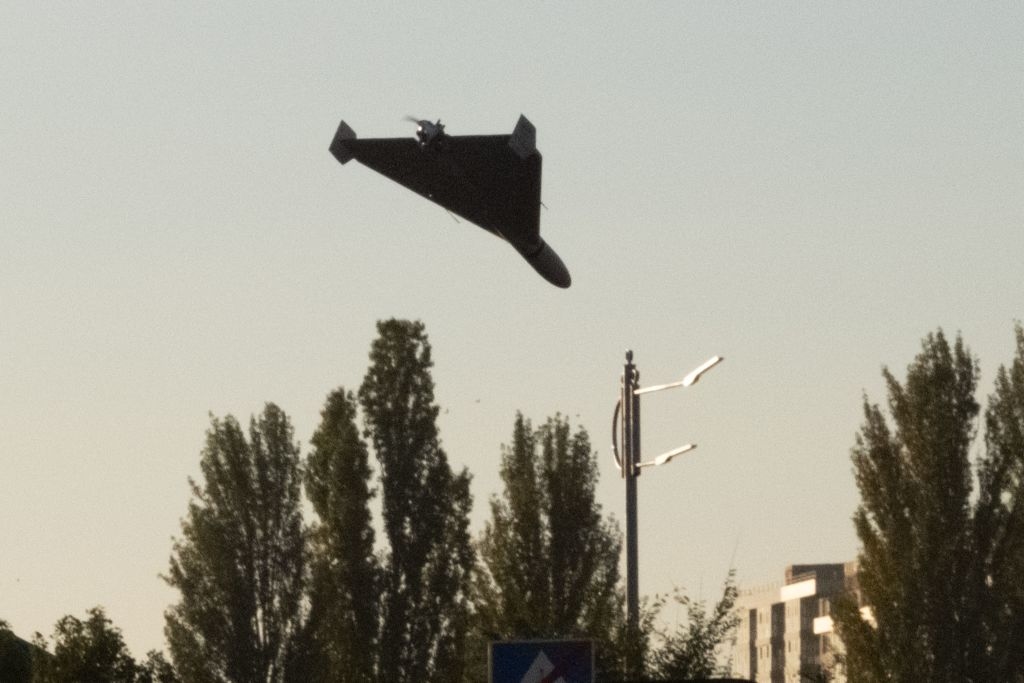How Russia uses Iranian drones to try to overwhelm Ukraine’s air defense

Russia's been shelling civilian housing and infrastructure since the war escalated on Feb. 24 and has a body count in the thousands to show for it.
But recently, Moscow prioritized attacking power plants throughout Ukraine, damaging more than a third with big missile and loitering munition attacks. Oleksandr Kharchenko, head of the Energy Industry Research Center, called it the largest infrastructure attack since World War II.
"Russia is using the same tactics that Nazi Germany tried to achieve against the British in 1940," said Federico Borsari, expert at the Center for European Policy and Analysis.
Russia has used thousands of ballistic and cruise missiles so far, each of which costs millions of dollars. This is unsustainable. It eventually needed to ration its precise, high-tech missiles, unable to keep domestic production up with use rate. To continue to pressure Ukraine from long range, Russia needed another solution.
The answer was found in masses of cheap Iranian "kamikaze drones," scores of which have attacked the country's power plants and residences over the past few weeks.
President Volodymyr Zelensky said that Russia ordered over 2,400 of these drones. Experts said that most of them are Shahed-136 models, but others appear to have been supplied as well. These include Mohajer-6 attack drones that carry separate payloads like the Turkish Bayraktar TB2 drones.
While stealthy and tricky to spot, loitering munitions are slow and easy to take down. Their most dangerous quality is their expendability. Using common parts, each drone costs up to $30,000, making it cost-effective to send many at once, forcing Ukraine to use up expensive air defense missiles and fail to prevent a dangerous fraction from getting through.
While Ukraine has air defense systems and is getting more from the West, it's not nearly enough to protect all critical infrastructure and cities across the entire country. Ukraine is massive, the largest wholly-European country by area.
Ukraine will need many more systems from its allies if it hopes to get through the winter with a significant part of its critical infrastructure intact. Many of these will, unfortunately, be expensive. Ukraine will also need to adjust its approach to air defense to be able to defeat the maximum number of Iranian weapons at the lowest possible cost.
Mutually beneficial partnership
Russia's partnership with Iran is convenient for both sides.
Iran has a more mature domestic drone production program than Russia. Drones, missiles, and loitering munitions are a significant part of its military doctrine, meaning Iran is building to its strengths. Iran is also less reliant than Russia on foreign components, which are harder to get while sanctioned.
Iran is also under international sanctions and has a bone to pick with Washington, which withdrew from the Iran nuclear deal and reinstated sanctions in 2018. In 2020, the U.S. killed the critically important Major General Qassem Soleimani, commander of Iran's Quds force, specializing in unconventional warfare and intelligence.
Iran also has a strained relationship with Ukraine after it shot down a Ukrainian International Airlines flight near Tehran, killing all 176 people aboard. Iranian authorities claimed they thought it was a hostile military aircraft, but that explanation didn't satisfy Ukrainians, who pressed for criminal liability and restitution for each victim.
"Iran doesn't really have that much to lose," said Marcel Plichta, a former analyst at the U.S. Department of Defense. "They have a lot to gain because… if they're getting money into their economy because drones are part of their regional strategy, that means, in terms of just the economics, they can fund more production."
Everyone knows that Iran is supplying tech to Russia, but Tehran has emphatically denied it, just like it denied supplying drones to Houthi forces in Yemen.
"It's pretty much the standard policy to deny that they're exporting drones," said tech journalist David Hambling.
Russia also sought to hide the source of these weapons — likely shipping in parts and doing final assembly in Russia. In keeping with its pretense, Russia has renamed the Shahed-136 to "Geran-2," the Russian word for Geranium. Its smaller brother, the Shahed-131, is dubbed the “Geran-1.”
Over the summer, dozens of Iranian flights could be tracked to Russia, possibly carrying military equipment.
John Kirby, the U.S. National Security Council spokesman, said Iran sent military trainers to Russian-occupied Ukraine to help Russians launch drones more effectively. Ukraine had stated that 10 Iranian trainers were killed in Ukraine. Tehran officially denied these claims.
"Russia's obviously kind of embarrassed by this" — that is its perceived inability to make its own arsenal of loitering munitions, said Plichta. In one Russian political talk show, a hot mic caught a defense expert being told to avoid the subject of Iran and drones.
Russia also tapped Iran for missiles. Yuriy Ihnat, a spokesman for Ukraine's Air Force Command, said that Ukraine has no effective answer for them at this time.

Cheap and simple
The Shahed-136 and its ilk are commonly called kamikaze drones, but the more accurate term is 'loitering munitions,' essentially a single-use missile that flies like a UAV.
Nothing about the Shahed-136 is complicated. It's a 3.5-meter-long delta-wing chassis, powered by a common four-stroke engine, like the sort that can be found in cars and motorbikes. The motor produces a distinctive buzz — Ukrainians have called it "the moped." In its nose, it carries a warhead, usually with 30 to 50 kilograms of explosive charge.
The claimed range of Shahed-136s is between 1,800 and 2,500 kilometers, allowing it to strike targets in Ukraine from many possible angles. Most of them have a GPS guidance system, meaning they don't need a dedicated human controller.
The small size and triangular shape gives the Shahed limited stealth characteristics — it's harder to pick up on radar than something with big, protruding wings. It doesn't actually have any dedicated stealth features, such as radar-absorbing coating or engine shielding.
What makes it harder to track is how it flies. Shahed drones frequently stay just 100 meters above ground. This makes them harder to detect and engage from a long distance due to the Earth's curvature and terrain features getting in the way.
Human-crewed and unmanned aircraft from both sides often fly very low, to avoid each other's deadly air defense systems, effective at deleting high-flying objects.
Once the Shahed is detected, it's very easy to bring down. Since Russia started using them against Ukraine, they have been destroyed by everything from advanced anti-air missiles to assault rifle fire from infantry on the ground.
So why would something so basic and vulnerable be such a problem for Ukraine? The answer is their extreme cost efficiency.
Shaheds-136 loitering munitions each cost between $20,000 and $30,000. They're easy to build, use common, readily available parts, and can be sent by the hundreds without making too big a dent in Moscow's military budget.
Compared to Russia's hypersonic missiles, which can cost up to $13 million, Shahed drones are a no-brainer for Russia if it wants to try to bomb Ukraine powerless and still afford to outlast it economically.
Dangerously expendable
According to Kyrylo Budanov, head of the Defense Ministry's Intelligence Directorate, Ukraine has shot down more than two-thirds of Shaheds launched by Russia.
The problem is, it spent a lot of expensive resources to do so. Many air defense systems cost over $1 million per missile. Even a man-portable Stinger costs more than one Shahed-136.
For a country that depends on foreign aid to defend its airspace, Ukraine can't really afford to keep using million-dollar missiles to kill $20,000 drones. Yet when one drone can damage a critical power plant, Ukraine also can't afford not to take them down.
Instead of bankrupting itself and running out of its missile stockpile, Russia can send swarms of cheap loitering munitions to run Ukraine's ammunition dry, making it more dependent on weapons from other countries, which Russia hopes have limited stamina for constant military aid.
"Russia is banking on both the Ukrainian government, and the Ukrainian population at some point running out of patience," said Samuel Bendett, an adviser with the military think tank CNA.
"Russia is banking on the European community, now that the winter is really approaching, to also pressure for some kind of deal or a resolution. Russians are also banking that the Western attention, especially U.S. attention, would turn away from Ukraine and towards other matters."
Many Shaheds can be sent at once. While Ukraine will shoot down most of them, some will usually get through and cause significant damage to the country's power plants and other parts of the electrical and heating infrastructure.
Budanov said 30% of Iranian drones have hit their targets and the terror will last for months.
Russia sometimes uses the tactic of sending multiple loitering munitions simultaneously with powerful missiles, trying to jam up the air defense grid, improving the chances of striking at least one stationary target.
"That makes that one missile more useful or increases the likelihood that the missile will hit," said Plichta. "The same goes in reverse as well. If they're only aiming at the missile, it's more likely that one or two of the drones might get through as well."
A similar tactic was used during Yemen's Houthi rebels' attack on Saudi Arabian infrastructure with Iranian drones. The Houthis launched multiple Iranian loitering munitions and missiles against big, stationary oil infrastructure objects. The ones that weren't shot down were able to do damage, forcing Saudi Arabia to take facilities offline.
How to fight them
Russia's attacks on Ukraine have expedited air defense system deliveries from Western countries. The U.S. agreed to provide NASAMS, France the Crotale, and Germany the IRIS-T, which are relatively short-range anti-air missile systems.
"I will say this, during the last enemy attacks, the modern IRIS-T system proved itself and worked really well," Ihnat said.
While effective, these weapons can only protect a limited area and are not quickly repositioned.
Ukraine still needs options to combat loitering munitions, including direct-fire anti-aircraft guns, which are cheaper per shot and can effectively defend a fixed point from slow-moving targets.
Germany's recently-delivered Flakpanzer Gepard guns have already distinguished themselves by taking down Iranian drones over Ukraine. However, these guns' range is even more limited than the missiles'.
Ukraine can also try to be proactive and try to intercept Iranian weapons before they are fired, Bendett said. This is called "left of launch" capability. Kyiv gets excellent intelligence from its Western partners, and if it can identify a place where these drones are stored or launched from, it can try to send its own munitions to sort them out.
Ukraine's own indigenous drone production program can easily be refitted into making weapons. The country's arms manufacturer Ukroboronprom announced it's developing a loitering munition with a 1,000-kilometer range and a 75-kilogram warhead.
Ukraine's HIMARS and Bayraktar TB2 attacks are feared by Russia for their deadly accuracy.
Electronic warfare is another important component. Jamming systems can disrupt the Shahed-136s communication with Russia's GPS satellites, making them unable to correct their course and start to drift.
Plichta said that five kilometers of jamming can cause them to miss by over 250 meters — great in the countryside, not so great in cities. If it leaves the jammed area, it can potentially course-correct. Some have been seen making turns, possibly suggesting human operators, Bendett noted.
Borsari said Ukraine also needs to create interoperability between all the different systems. This is very difficult, although it helps that the country has eight years of experience fighting Russia.
Ukraine will require the West to continue to supply simple and advanced weapons and ammo, not just to protect the sky but to win the war against Russia.
"We need to rethink our way of approaching the defense sector," said Borsari. "We don't have enough stocks of ammunition."
"That's why it's important for Europeans to create some joint production of ammo that can benefit all countries and supply Ukraine for the long haul," he added. "This is easier said than done."
____________________
Note from the author:
Hi, this is Igor Kossov, I hope you enjoyed reading my article.
I consider it a privilege to keep you informed about one of this century's greatest tragedies, Russia's ongoing invasion of Ukraine. With the help of my colleagues, I will continue to bring you in-depth insights into Ukraine's war effort, its international impacts, and the economic, social, and human cost of this war. But I cannot do it without your help. To support independent Ukrainian journalists, please consider becoming our patron. Thank you very much.










